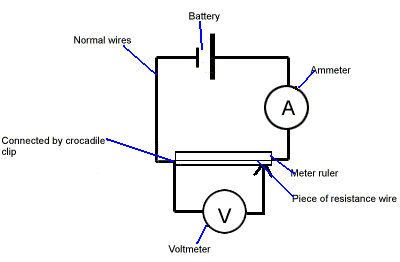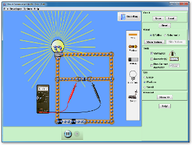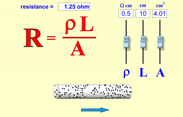Hamilton on a calm night. The importance of electricity to our everyday lives is obvious. A hundred years ago this would have been in darkness.
|
next topic >>
|
9.2 - Resistance
- To understand that electrical resistance slows down a current and transfers energy as heat.
- To be confident in applying Ohm's Law in electrical problems.
- To understand what factors affect the resistance of a wire.
- To know that not all components have a constant resistance - e.g. filament bulb.
If the cell was to keep pushing and pulling the electrons around the circuit and there was nothing impeding their movement, their speed would quickly escalate. There is something that hinders them though and this is known as resistance. I tend to think of resistance as the "friction" inside a circuit. Like friction, resistance converts the motion of the electrons to heat. Like friction, the higher the resistance, the slower the electrons move. It is not caused by friction though - but that is another story for another day. The current that flows is proportional to the voltage applied and inversely proportional to what is opposing it.
\[I = \frac{V}{R}\]
Which is usually remembered in its rearranged form:
\[V=IR\]
This is known as Ohm's Law and is fundamental. Experimentally, resistance can be determined by varying the voltage, recording the current and plotting a graph. This yields a straight line graph if the resistance is constant. For some components the resistance varies. The most common being an old-fashioned light bulb. The filament of which gets VERY hot. As its temperature increases, the resistance increases too.
\[I = \frac{V}{R}\]
Which is usually remembered in its rearranged form:
\[V=IR\]
This is known as Ohm's Law and is fundamental. Experimentally, resistance can be determined by varying the voltage, recording the current and plotting a graph. This yields a straight line graph if the resistance is constant. For some components the resistance varies. The most common being an old-fashioned light bulb. The filament of which gets VERY hot. As its temperature increases, the resistance increases too.
The resistance of a wire depends on three variables:
- the length of the wire, the longer it is the higher the resistance
- the thickness of the wire, the higher the cross-sectional area the lower the resistance
- the material of the wire, the resistivity. Copper has a lower resistivity than ni-chrome alloy.
Physics Aviary Problem




